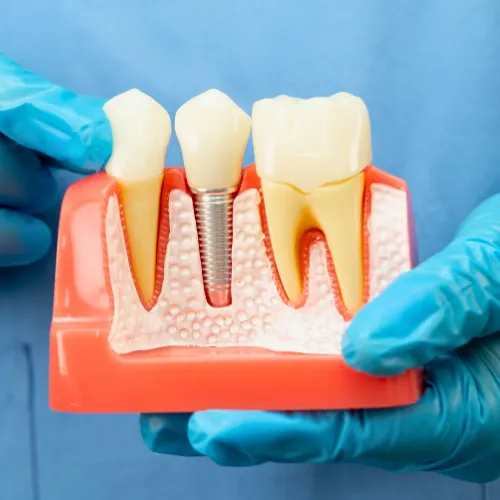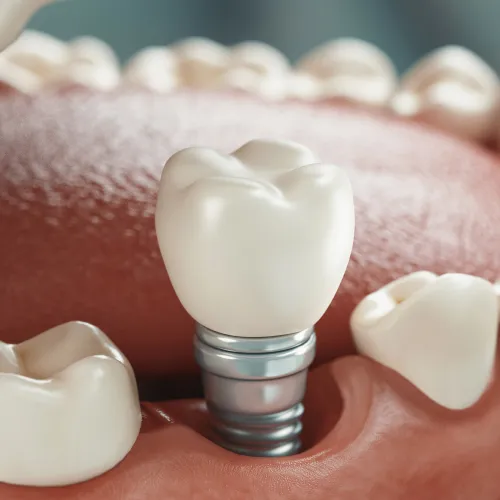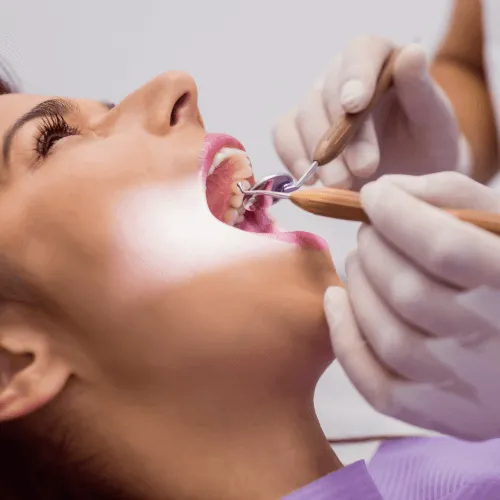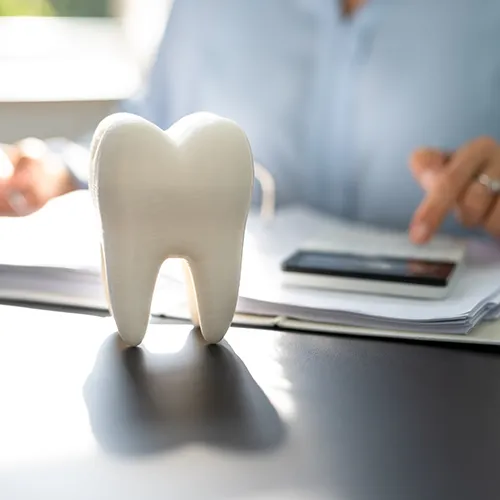Restorative Dentistry, Implant Dentistry
What Really Happens During Dental Implant Placement
Dental implants have transformed how we replace missing teeth. Instead of relying on removable dentures or bridges that alter nearby teeth, implants create a lasting, natural solution anchored in your jaw. But while the end result is often life-changing, many people are curious about what actually happens during the placement process.
This blog takes you behind the scenes of implant treatment at Vartanian Dental Group and what to expect.
How many visits are involved with implant treatment?
For most patients, dental implant treatment involves several visits spread out over a few months. The exact number depends on your oral health, the type of implant, and whether additional procedures like bone grafting are needed.
The journey usually begins with an initial consultation. This first visit is where we carefully evaluate your mouth and overall health. Digital X-rays and 3D scans help us assess bone density, tooth positioning, and sinus structures. We also review your medical history, lifestyle habits, and personal goals. This step is crucial because it allows us to design a tailored treatment plan instead of a one-size-fits-all approach.
The second visit often involves any preparatory procedures. If you need a bone graft to strengthen the jawbone or tooth extractions before placement, those are scheduled and completed first. Not everyone needs this step, but when it is required, it ensures that your implant will have a solid, healthy foundation.
The third visit is implant placement day. This is the surgical appointment where the titanium post is gently inserted into the jawbone. In some cases, if your bone quality is excellent and healing is expected to be straightforward, we may place a temporary crown or healing abutment on the same day.
After placement, you will return for check-ups during the healing period. These visits are shorter and allow us to monitor your progress, make sure the implant is integrating well with your bone, and address any concerns early.
The final major visit is the restoration appointment. Once the implant has fully fused with your jawbone, we attach the custom abutment and the permanent crown. This crown is designed to match your natural teeth in both color and shape. The result is a replacement tooth that looks and functions just like the real thing.
While every case is unique, most patients can expect between three and five visits from start to finish. More complex cases may involve additional appointments for grafting or follow-up scans.
The number of visits is not just about quantity but about ensuring each stage is done correctly so your implant lasts for decades.
Is placement painful?
The short answer is no, dental implant placement should not be painful. Modern techniques and local anesthesia make the procedure surprisingly comfortable for most patients.
Before the implant is placed, we numb the area completely. You will feel pressure during the procedure but not pain. Many patients compare it to having a filling or a tooth extracted, but often say it is easier than they expected.
For patients who feel anxious or prefer added comfort, we also offer sedation options. This helps you stay relaxed throughout the procedure. Sedation is not mandatory, but it can be a good choice if you have dental anxiety or are undergoing multiple implants at once.
During the actual placement, a small opening is created in the gum to expose the jawbone. A precise channel is shaped in the bone using specialized tools, and then the implant is gently screwed into place. Because we use detailed imaging beforehand, the procedure is carefully mapped to avoid nerves and maximize accuracy. The gum is then sutured around the implant, and a healing cap may be placed to protect it.
After the anesthesia wears off, it is normal to feel mild soreness or tenderness for a few days. Most people describe it as similar to what you might feel after a routine extraction. Over-the-counter pain medication usually handles any discomfort. Swelling is minimal and typically subsides within a few days.
To help you heal quickly, we provide clear aftercare instructions. These include how to clean the area, what foods to avoid temporarily, and when to return for follow-up checks. If you follow these instructions, the recovery is smooth and uneventful for most patients.
It is worth noting that the implant is placed into bone, which has fewer nerve endings than teeth. This is one reason why the procedure tends to feel less intense than patients imagine.
With skilled planning, proper anesthesia, and attentive care, implant placement should feel manageable and surprisingly straightforward.
How long does it take to heal?
Healing after dental implant placement takes several months on average. In most cases, the initial recovery period is short, but the bone integration process continues beneath the surface for some time.
The first few days after surgery are focused on soft tissue healing. The gum around the implant will start to close and settle. Most patients feel well enough to return to normal routines within one to two days. During this time, gentle oral hygiene and soft foods help protect the area.
The next and most important phase is osseointegration. This is when the bone gradually fuses to the implant, creating a stable and secure anchor. For most people, this process takes three to six months. Bone quality, overall health, and whether grafting was needed all influence the timeline.
In some situations, patients with excellent bone density may qualify for immediate loading, where a temporary crown is placed on the same day as the implant. However, this is not suitable for everyone. For most cases, waiting for full integration ensures the best long-term results.
During healing, we schedule periodic check-ups to monitor progress. We examine the gum tissue, check stability, and make sure no complications are developing. If you follow your aftercare instructions, avoid smoking, and maintain good oral hygiene, the healing phase typically proceeds without issues.
Once integration is complete, we place the permanent restoration. This is when your new tooth truly comes to life. The custom crown is secured to the implant, giving you the function and appearance of a natural tooth. From this point on, your implant becomes part of your daily life, allowing you to chew, speak, and smile with confidence.
Although healing may sound lengthy, most of the time is passive. You will not be in discomfort for months. Instead, your body is quietly working behind the scenes to create a strong foundation that will last for decades.
Step by Step: What Your Implant Appointment Looks Like
To make things clearer, here is a closer look at what typically happens on implant placement day itself.
- Numbing the area: We apply a local anesthetic to ensure complete comfort before starting. If sedation is chosen, that is administered as well.
- Creating access to the bone: A small incision is made in the gum to expose the bone where the implant will sit.
- Preparing the site: Using specialized instruments, we create a channel in the bone that matches the exact dimensions of your implant.
- Placing the implant: The titanium post is gently screwed into place at a precise angle and depth for maximum stability.
- Securing the area: A healing cap is attached to protect the implant, and the gum is sutured around it.
- Post-procedure check: We give you instructions, schedule your follow-up, and make sure you feel comfortable before you leave.
The entire appointment typically lasts one to two hours, depending on how many implants are placed and whether additional steps are needed.
Why Dental Implant Placement Requires Skill and Planning
Many people assume that dental implants are a routine procedure that any dentist can perform. While they have become more common, successful outcomes depend on meticulous planning and precise execution.
At Vartanian Dental Group, we use advanced imaging to plan every implant placement. This allows us to evaluate the ideal angulation, depth, and spacing before any surgery begins. We consider bone density, proximity to nerves, and aesthetic factors like gum contours and smile lines.
This planning means that on surgery day, we are not improvising. Instead, we are following a carefully mapped plan that minimizes risks and maximizes long-term success.
Equally important is the quality of the materials. We use high-grade titanium implants that have been clinically tested for durability and biocompatibility. Cheaper implants may seem attractive initially but can lead to complications or failure later.
Lastly, post-placement care is part of the process. Regular check-ups, good oral hygiene, and professional cleanings keep your implant healthy for years to come. Think of the placement as the foundation, but maintenance is what keeps the structure standing strong.
When to Schedule Your Consultation
If you have been living with a missing tooth or an uncomfortable bridge, dental implants could be the solution that changes your daily life. The earlier you explore your options, the more choices you have for planning the best outcome.
At Vartanian Dental Group, we believe in clear communication and personalized treatment. We will walk you through each step, answer every question, and create a plan that suits your unique needs.



































Best smiles Mission Viejo, CA
#VartanianDentalGroup
Check us out and follow our accounts on the following social media platforms for more healthy smiles....